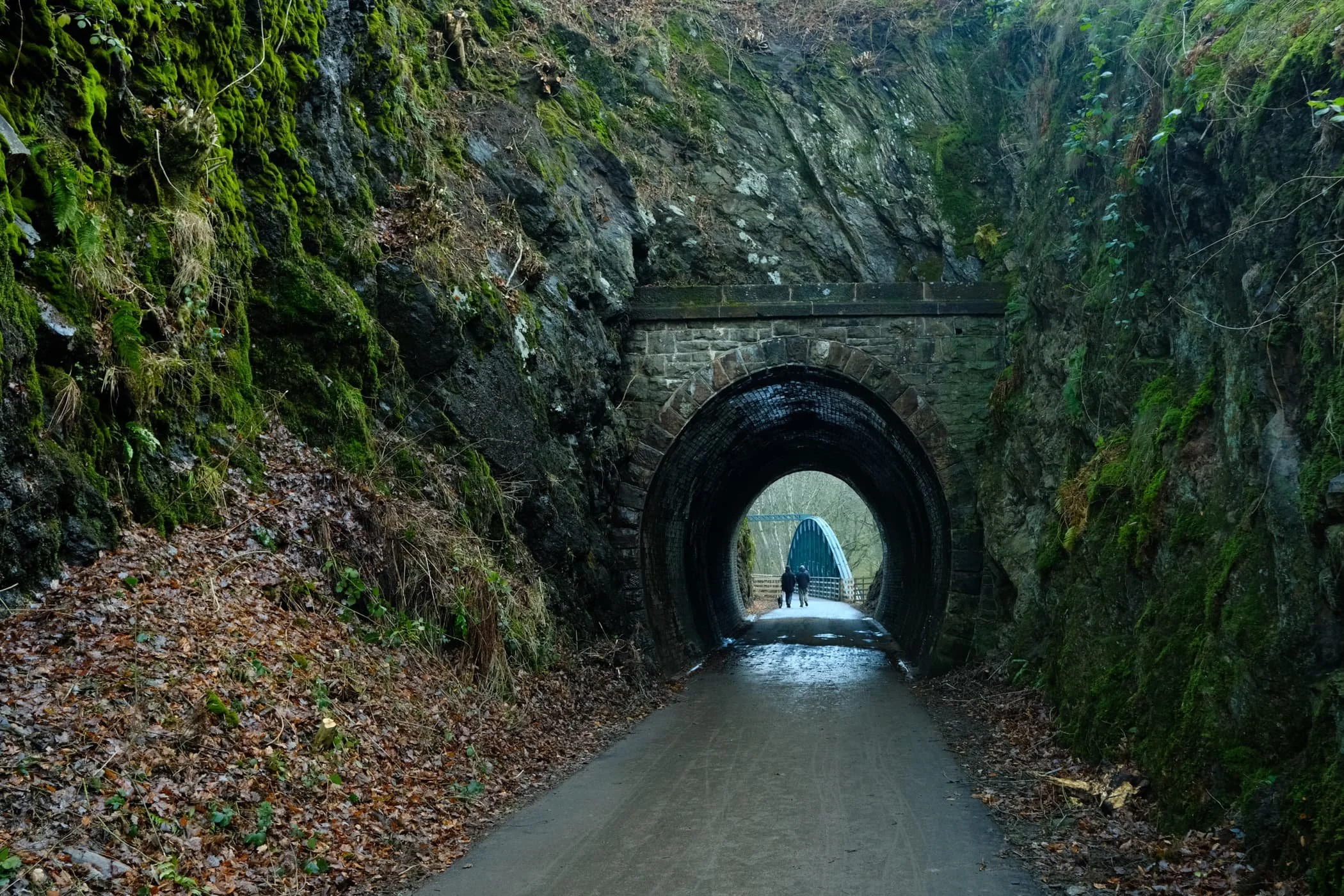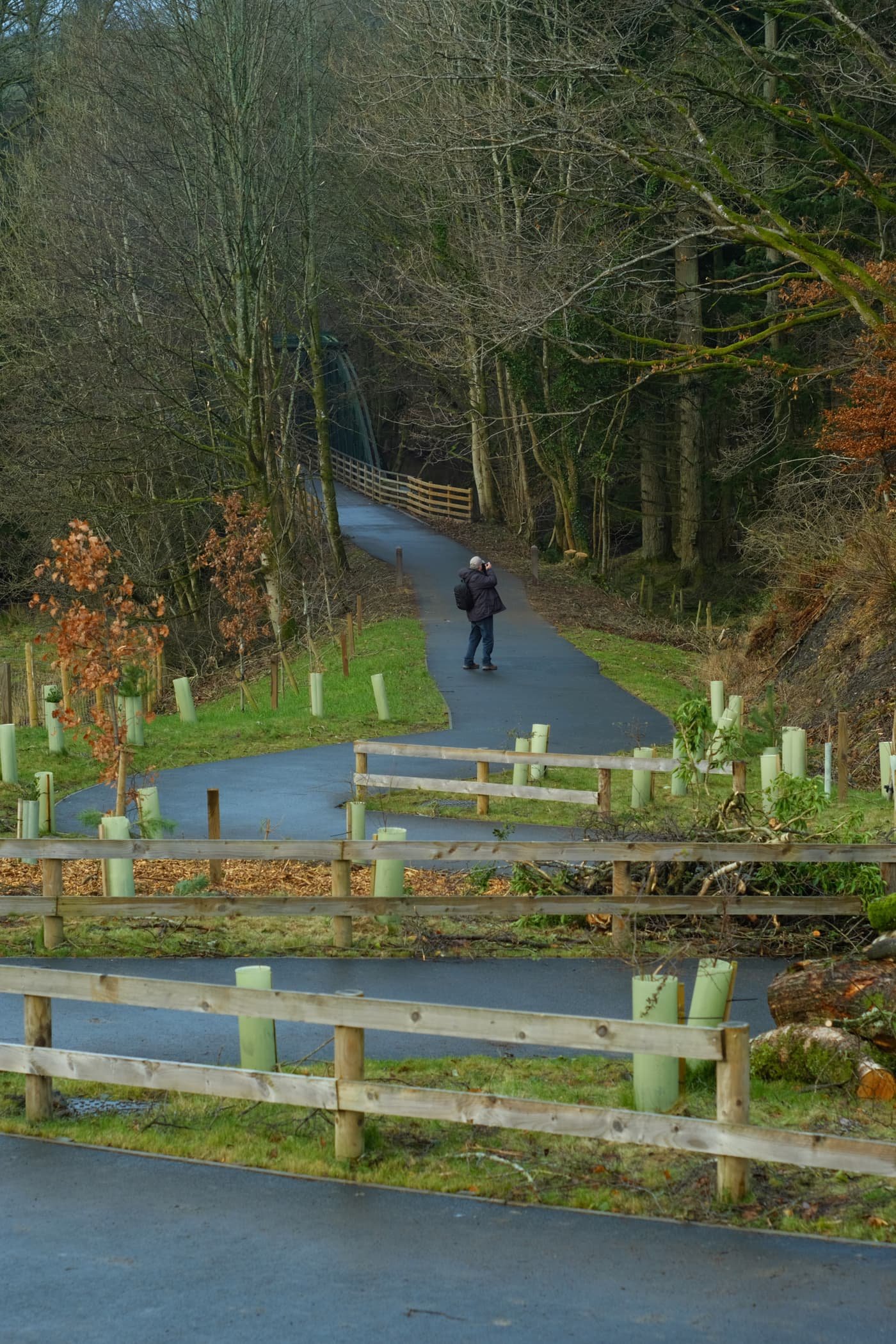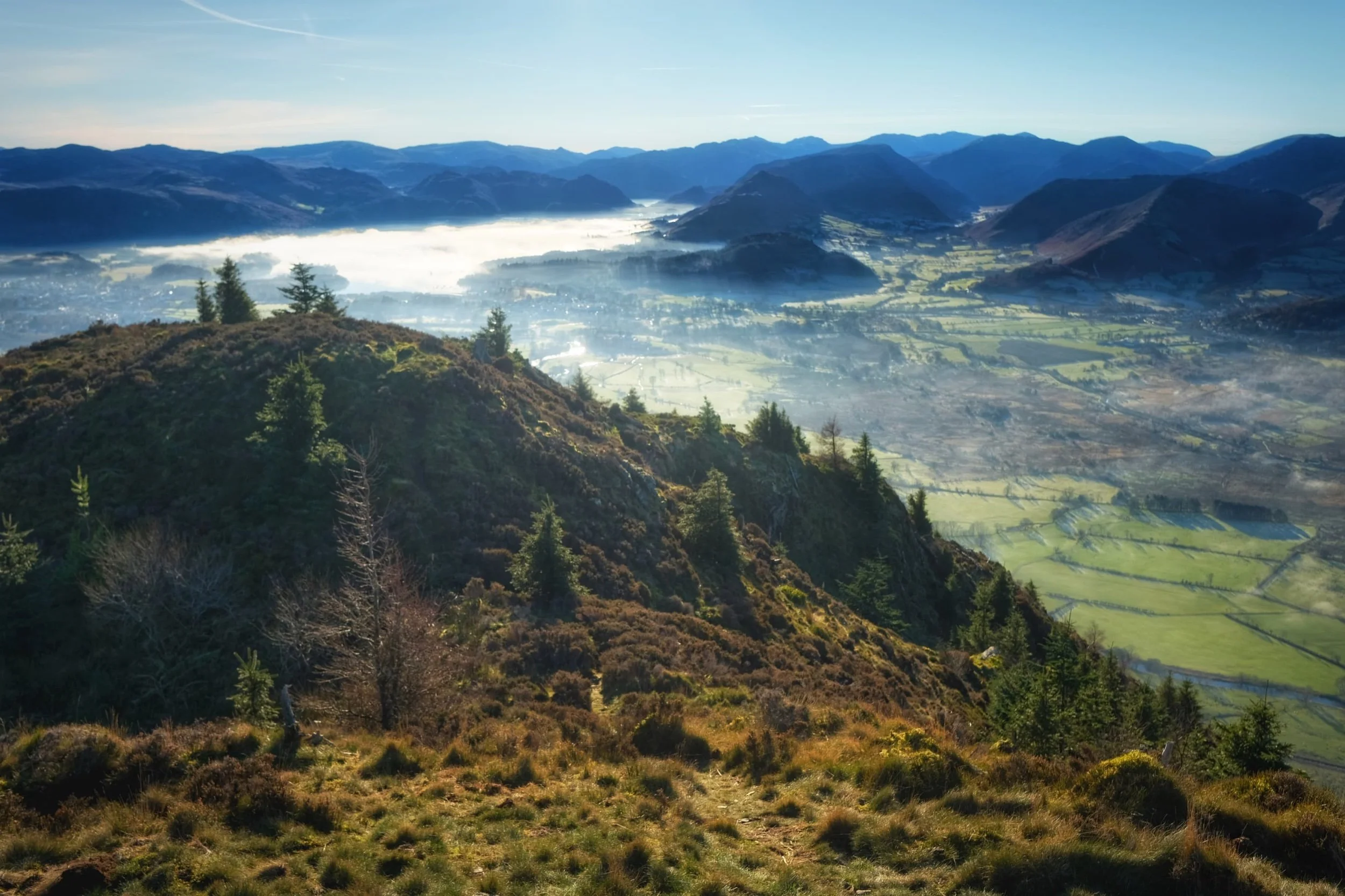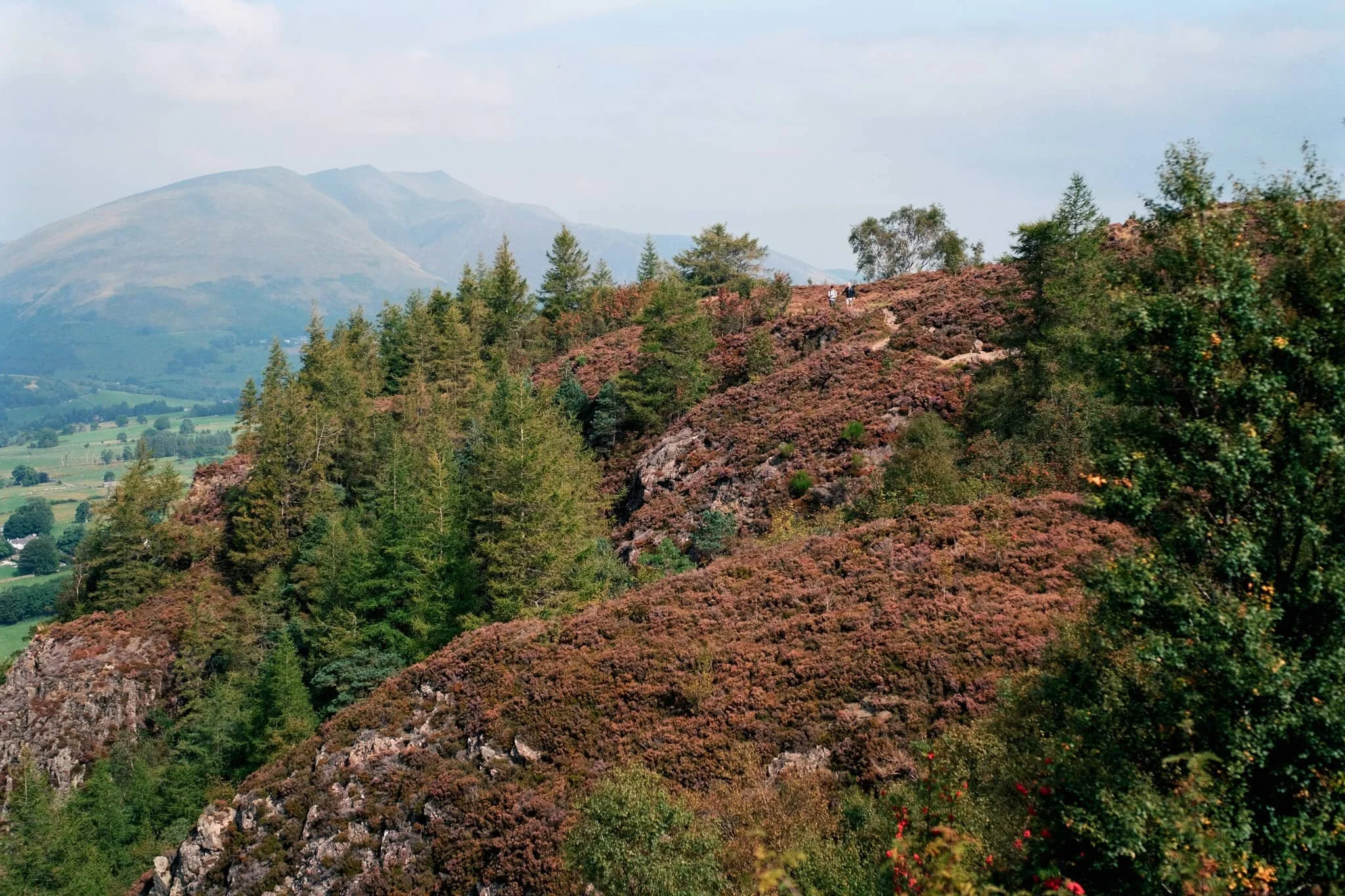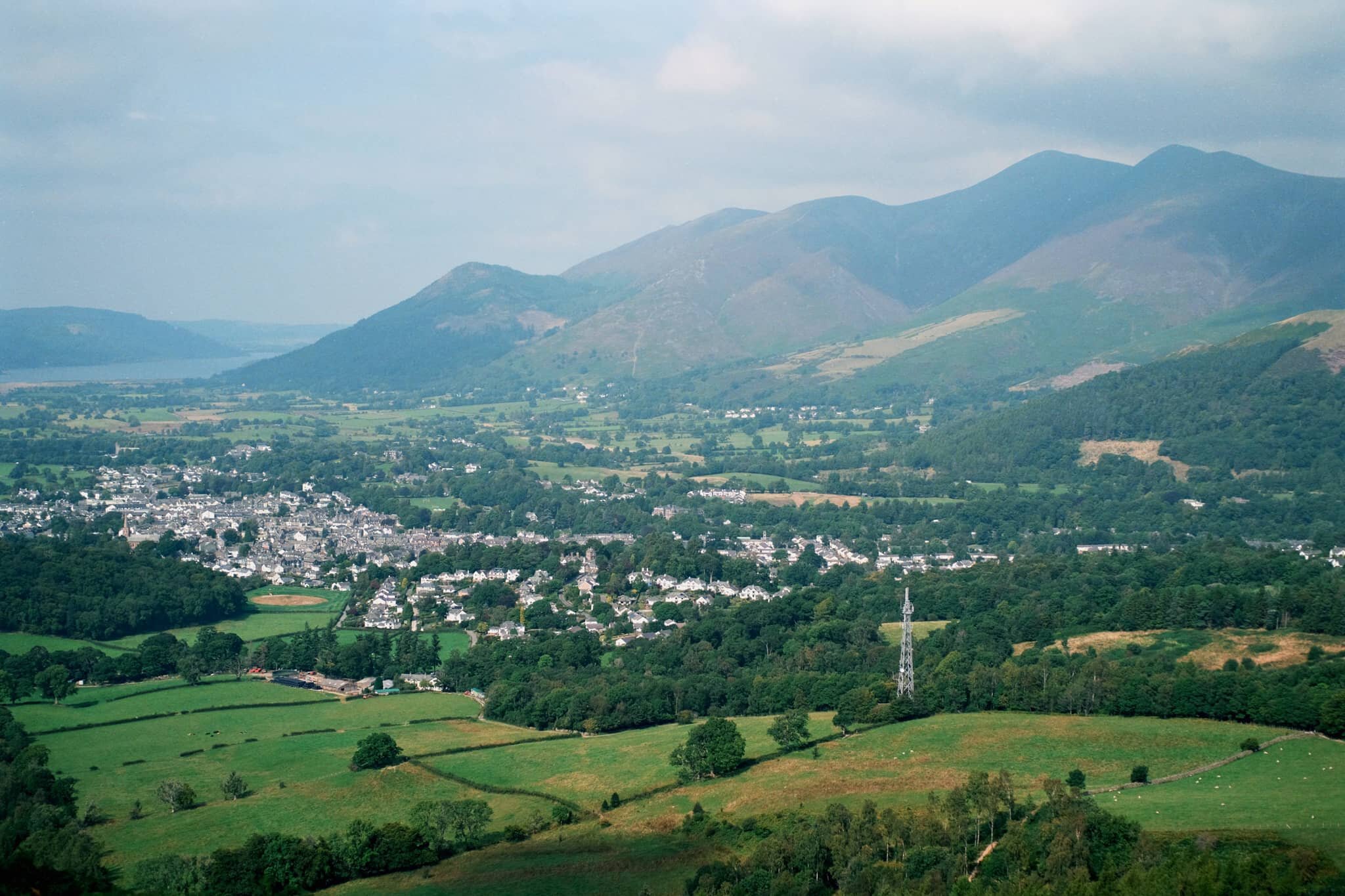Walla Crag, Lake District, Summer
A 4am start.
A 4am start.
The UK is on the cusp of a record-breaking heatwave, kicking in Sunday evening/Monday morning. Even before the real heatwave arrived, Sunday’s temperatures up here in Cumbria were looking to peak at around 26°C. Not only that, summer in the Lake District is easily its busiest time. So what to do?
Wake up before the sun rises and get to our destination before everyone else.
We decided on revisiting the small Walla Crag above Derwentwater, a new favourite after our first venture in autumn last year. Upon leaving the house we were greeted with something we didn’t expect before a heatwave, but probably should’ve anyway.
Rain.
We pulled up at the parking spot, and thankfully it only took 15 minutes or so for the rain to cease. By about 6:40am we started the walk up to Walla Crag.
Although the rain had cleared, it was still completely overcast even as temperatures quickly rose. The sun was not able to break through. So although light conditions were not the best, the views were still utterly magnificent.
All photos taken on my Fujifilm X-T2 using my Vivitar “Series 1” 28–105mm f2.8–f3.8 zoom lens. Shot using the Classic Chrome film simulation, developed in Capture One for iPad, cleaned up in Affinity Photo for iPad.
Walla Crag, Lake District, Summer by Ian Cylkowski is licensed under CC BY-NC-SA 4.0
Across the fields from the Walla Crag path, Low Rigg looks diminutive against the imposing crag face of Clough Head, part of the Helvellyn range.
As we began the steep ascent up to Walla Crag, the views looking back opened up quickly. Here, Blencathra’s beautiful shape is unmistakeable.
The way up to Walla Crag, a short and sharp ascent.
Once up on the more level part of the fell, a small gate through the drystone wall allows you to take the more exploratory route to Walla Crag’s summit. Near the crag’s cliff edge, clear panoramas can be enjoyed across Derwentwater to the Grisedale fells.
Back along the cliff edge towards Blencathra, already there is some heather starting to appear. Give it another month or so for it to be in full resplendent bloom.
The smooth multi-peaked profile of Skiddaw, England’s 6th highest peak.
Walla Crag’s cliff face is lush, chock-full of fern, trees, heather, and loads of other flora. Lisabet discovered a small bilberry bush, and helped herself to a couple of the tart berries.
The summit of Walla Crag! Looking back north towards Skiddaw, a dominant presence on the Keswick skyline.
Derwentwater looks dry, with a couple of new islands becoming exposed as the water level drops.
One final composition from the summit, this time featuring Blencathra’s curved forms.
Walking towards the Jaws of Borrowdale.
Probably my favourite composition of the day. The drystone wall keeps livestock out of the Walla Crag area, allowing flora to flourish. In the distance is Derwentwater’s southern tip with the Borrowdale fells high above.
The other side of the same wall, featuring more of the Catbells ridge.
On the way back down the fell, I couldn’t resist revisiting this composition.
Pretty happy with how this shot of a family of fell ponies came out.
Did you like these photos?
Keswick–Threlkeld Railway, Lake District, Winter
And now for something completely different.
And now for something completely different.
After yesterday’s thrilling circular hike around the gorgeous and epic Malhamdale, today we embarked on something a little more tourist-friendly and flat: the Keswick–Threlkeld Railway walk.
The 5km walk follows the route of the old Cockermouth, Keswick and Penrith Railway from Keswick to Threlkeld. It was constructed in 1864 with the goal of connecting the town of Cockermouth with the London and North Western Railway (LNWR) West Coast Main Line at Penrith. It closed to passengers and business in the 1960s and 1970s.
Much of the trail was badly damaged or totally destroyed by Storm Desmond in December 2015. Major restoration work was undertaken and the trail was upgraded and reopened in December 2020.
Lisabet and I met met up with me Dad near the start of the trail at Keswick, and followed the route all the way to Threlkeld and back, a good 6.2 miles and 17,000 steps later.
We were blessed with lifting hill fog, resulting in some incredible scenes of clouds whipping around the shoulders of nearby fells Lonscale Fell, Blencathra, and even some of the Helvellyn fells.
This route will definitely be one to revisit in Spring and Summer.
All photos taken on my Fujifilm X-T2 using my three prime lenses: a Fujinon 23mm f/2.0, a Laowa 9mm f/2.8, and an adapted Pentax SMC 55mm f/2.0. Images made in-camera, with no additional editing, using Øyvind Nordhagen‘s Overcast Fujifilm recipe.
The Keswick Hotel, which also seems to come with its own garage. At least, it used to.
The aforementioned Keswick Hotel Garage.
The Keswick–Threlkeld Railway trail starts near Keswick Leisure Centre, alongside the old station. I nabbed a sneaky shot of me Dad.
It wasn’t long before the trail started offering some lovely views along the River Greta towards the fells above Keswick. The main fell pictured here is a favourite of ours, Latrigg.
Where possible the Lake District National Park have tried to save and restore as many of the old Victorian bridges and tunnels as possible.
Near the “big” tunnel there’s a little commemorative sculpture, erected to celebrate the National Cycle Route and the Coast to Coast trail.
Into the “big” tunnel we go…
Again, beautifully preserved Victorian engineering, now with the added convenience of modern lighting and smooth, durable tarmac.
On the other side of the tunnel, panoramic views of the River Greta and Latrigg open up.
Despite being in winter, it was lovely to still see some colour about.
One of many of the newer bridges that criss-cross the winding River Greta.
Evidence of Storm Desmond, which scoured the river banks clean. You can still the level that river came up to during the storm. Land slips ahoy.
A nice little holiday village, Low Briery, alongside the River Greta.
The trees now denuded of their leafy vegetation, line the river and serve as a leading line towards Latrigg.
Onwards to the next bridge. There were plenty of other people around enjoying this trail. It was a good job we got started nice and early.
The next bridge to cross the River Greta. The Greta Gorge flattens out at this point, providing “in-bye” land for nearby hill farmers to use for their grazing flocks of sheep.
I wanted to play with lines and angles provided by this bridge, so I snapped on my ultra-wide 9mm lens for some fun compositions.
Not a bad spot for a bit of lunch.
The gorge created of the River Greta flattens out here, opening more perspectives of the Latrigg fells above.
To the north, the clouds were starting to lift from mighty Blencathra.
A solitary tree has survived erosion and storms against all the odds, and stands proudly in the middle of the river.
The excitement levels rise as we catch our first glimpse of Blencathra’s jagged peaks.
Additionally, to the east, the morning hill fog was wrestling with the crags of Clough Head, part of the Helvellyn range.
Beyond Latrigg, the crags of Lonscale, too, were freeing themselves of the morning’s mist.
The shoulder of Lonscale Fell high above the Greta Gorge.
Another relic of Victorian engineering, a small tunnel blasted through the crag leading to Rawsome’s Bridge.
Near Threlkeld, lots of trees were covered in beautiful and vibrant moss as the gorge walls closed in.
The end of the trail. Beyond the A66, Clough Head provides a dramatic backdrop as it tussles with the clearing fog and mist.
Blencathra’s craggy and jagged peaks, now nearly clear of morning mist.
Dad leads the way back to Keswick, happily snapping away.
There’s something wonderfully eldritch about wintery trees covered in moss.
Quite happy with this candid snap of me Dad.
Lonscale Fell again, now apparently losing its battle against the sky.
Blease Fell below Blencathra, and a band of mist clinging to its shoulder.
At around lunchtime, the sun finally broke through the thick cloud cover and illuminated these trees in golden light.
Overall, I can heartily recommend this trail. I look forward to returning in the spring and summer, when there’s more wildlife and flora about.
Dodd, Lake District, Winter
Thankfully a dry, if bitingly cold, weather system has descended on the British Isles.
Thankfully a dry, if bitingly cold, weather system has descended on the British Isles.
On the Saturday, Kendal was engulfed in a soupy-think mist. It almost seemed to muffle the world in a pillow. In actuality, a temperature inversion sat on top of a lot of Lake District valleys, including Kendal. Conditions above the inversion were clear, sunny, and bright.
So, for the Sunday, we decided to head to the Northern Lakes for a hike up Dodd, part of the Skiddaw range. Local weather reports indicated that a temperature inversion would continue to cling to the fells below 450 m or so, but otherwise the day would be sparkling clear above. Dodd measures 502m above sea level.
In the end, the temperature inversion wasn’t quite as extensive around the Northern Lakes, mostly sitting on top of Derwentwater. Nevertheless, conditions were glorious, the Lake District was quiet, and hiking Dodd is always a good exercise.
All photos shot on my Fujifilm X-T2 using my three prime lenses: a Fujinon 23mm f/2.0, a Laowa 9mm f/2.8, and an adapted Pentax SMC 55mm f/2.0. Images were bracketed handheld, merged and blended in Affinity Photo, then finalised in Snapseed.
The Old Sawmill Tearoom, at the car park below Dodd. A beautifully quaint and cosy place.
Hiking up Dodd is simple enough. Just the follow the green signposted trail. As we did we rose above the leftover mist in the woods, and the sun pierced through the woodland.
Most of Skiddaw, like a lot of Lakeland fells, lacks significant tree cover. Dodd’s an exception, and its dense woodland is managed by the Forestry Commission.
Couldn’t resist snapping a composition of this Sleepy Hollow-esque tree, seemingly pointing the way up through the woodland.
As we started to emerge above Dodd Forest, more of the fell’s rough and craggy summit becomes apparent.
One of many incredible views you can enjoy around the summit of Dodd. Above the woods and the temperature inversion, a clear sight towards the Helvellyn range reveals itself.
It’s hard to keep up the hiking momentum when panoramic views like this constantly vie for your attention.
Nearing the summit of Dodd. To the left a temperature inversion clings to the surface of Derwentwater, creating a lake-sized mirror reflecting the morning sun. To the right are the Newland fells; tiny tufts of fog cling to dales below.
From the summit of Dodd. Bassenthwaite Lake was impossibly still, and the atmosphere was clear that you could see all the way across to the Cumbrian coast and beyond to Galloway in Southwestern Scotland.
We rested on the summit for coffee and fruit, but I had to snap another composition looking back to the magnificent shapes of the Helvellyn range.
With my 55mm attached I tried for some focused compositions of some of the nearby fells from Dodd summit. The wooded fell here is Barf (yes, that’s right).
The shapely peak pictured above the dale here is Grisedale Pike.
As we started to descend, more compositions offered themselves to me. Immediately above is the southern face of Carl Side with Little Man behind it.
The way back down Dodd’s southern aspect is quite steep, but no less beautiful.
As we near the bottom, Ullock Pike glows in the midday wintersun.
Despite being in winter, Skill Beck was surprisingly lush and verdant.
The remnants of Storm Arwen’s destruction made for some nice ultra-wide compositions.
There’s a lot of lush fern to be found alongside Skill Becks many mini waterfalls.
Another casualty of Storm Arwen, now left where it fell to provide life and nourishment for all denizens of the forest.
Walla Crag, Lake District, Autumn
Autumn has arrived.
Autumn has arrived.
The “life” from all the verdant vegetation is starting to wane, the ferns are turning rust-hued, and the leaves are beginning to drop. Autumn’s here, and I cannot wait for those autumnal colours.
Whilst we wait, we decided today on a venture up a relatively small fell that we’ve never tried before: Walla Crag (379 m/1,243 ft).
At “only” 379 m tall it’s definitely one of the smaller fells, especially when compared to some of the giants in the area such as Skiddaw (931 m/3,054 ft) and Blencathra (868 m/2,848 ft). Nevertheless, what it lacks in height it makes up for in the jaw-dropping views it offers from its summit.
All photos shot on my Fujifilm X-T2 using my three prime lenses: a Samyang 35mm f/1.2, a Laowa 9mm f/2.8, and an adapted Pentax SMC 55mm f/2.0. Developed using RNI Films’ Kodak Ektar 100 profile.
Not far along the trail and already the views really open up. A couple enjoy a picnic in the sun with the backdrop of the Helvellyn fells behind them.
A row of Roman trees, Sorbus aucuparia, filled with their fruit frame the trail looking back to Blencathra in the distance.
The trail starts rising, offering up views looking back towards the likes of Lonscale Fell (715 m/2,346 ft).
By now the full profile of Skiddaw, its fells, and the smooth profile of Latrigg are fully exposed. It’s turning out to be a crackin’ day.
Plenty of other fell walkers were making their way up and down the trail. To the left in the distance is the magnificent slopes and peaks of Blencathra.
Skiddaw’s multi-peak shape looms of the bonny town of Keswick.
On our way up, the views towards the Derwentwater Fells, too, soon open up and our sense of anticipation grows.
Rowan trees and their vivid berries frame the Derwentwater fells on a somewhat hazy day.
Another lovely aspect to Walla Crag’s environment is the sheer abundance of pink heather everywhere.
The water level at Derwentwater is ridiculously low. New gravelly islands are reappearing and existing ones are gaining new shores.
It soon becomes apparent how much of a drop there is from Walla Crag’s northwestern face.
As more sun comes out, I spot another framing opportunity full of colour.
Looking back at the cliff-edge trail we followed. The amount of heather around Walla Crag is ludicrous.
Like, so much heather…
Aaaand… summit! Plenty of other folk enjoying the views from Walla Crag summit too. We stop for a quick bite and some water, taking the panorama in.
My ultra-wide 9mm lens was able to take in the vast panorama available from the summit of Walla Crag. One of the best views in the whole of the Lake District.
With my 55mm attached, it was time to pick out some smaller scenes amongst the vast panorama. The hazy conditions allowed for a wonderful layering affect with Derwentwater Fells.
Mighty Skiddaw looming above Keswick.
After taking everything in, it was time to follow the trail back down from the summit towards the main path off Walla Crag, with heather still in abundance.
Looking across the moorland and ferns, deep into the Jaws of Borrowdale.
Fellow hikers branch off from the path to take in the views towards the Helvellyn range, and Clough Head (726 m/2,382 ft) in particular.
Seemingly endless layers of fells in Borrowdale.
On the way back down off the fell, I spot this tree and arrange it underneath the peaks of Blencathra.
Magnificent Blencathra, demanding our constant attention as we climb off the shoulders of Walla Crag.
This is Armillaria mellea, or honey fungus. Apparently highly revered for its edible qualities, though a lot of UK species react with alcohol badly in people’s bodies causing nausea and vomiting. It’s generally best to parboil these mushrooms, and not consume alcohol for a day before and after eating them.
Follow other hikers along the trail back down to the car. The haze appears to lift somewhat around the Helvellyn fells.
The Helvellyn range above, with High Rigg and Low Rigg below.
Another fantastic day.
Latrigg, Lake District, Winter
It’s really starting to feel like winter in the Lake District now.
It’s really starting to feel like winter in the Lake District now.
As the weather improved over the Christmas Break, Lisabet and I decided to embark on a hike up a fell we’ve never done before: Latrigg.
Latrigg is a rather unassuming fell, measuring only 368 m/1,207 ft high. But what it lacks in height or stature it more than makes up for with the views it has to offer.
Technically Latrigg is part of the main Skiddaw massif, the mountain range that looms above Keswick town, disconnected by a depression that drops to 900+ ft. For those with limited mobility it’s possible to reach the summit of Latrigg via a car park near the peak. We decided instead to start in Keswick and hike up the Cumbria Way to the summit.
We certainly weren’t alone and we could easily see why. The day was ice-cold and clear, with gorgeous low winter light filtering through an atmosphere of ice crystals, resulting in shows of 22° halos around the sun and mist lingering around the fells. Skiddaw, Blencathra, and the Derwentwater fells also had plenty of snow on their peaks, adding to the sense of awe.
I hope these photos convey the beauty we experienced on this hike.
All photos shot on my Fujifilm X-T2 using both my Samyang 35mm f/1.2 and Laowa 9mm f/2.8 lenses. A variety of Fuji’s film profiles were utilised in the RAW developing.
As we ascended up the steep section of the Cumbria Way, the views looking back west and southwest grew more impossible to resist photographing. The sun was too weak to burn away the morning’s temperature inversion, leaving floating tufts of mist to meander around the fells.
As we broke off the Cumbria Way to take the path up towards the Latrigg summit, and patch of mist floated our way and obscured views back towards Skiddaw (931 m/3,054 ft). I quickly nabbed this 35mm composition of what turned out to be a fleeting moment.
We joined, at a distance, other groups of people near the summit of Latrigg, admiring the views and the incredible light show. The halo around the sun is known as a 22° Halo, caused by sunlight refracting through millions of hexagonal ice crystals in the atmosphere. The lake in the distance is Derwentwater.
From the summit of Latrigg, looking back towards the Derwentwater and Whinlatter fells as another patch of mist slowly creeps up the shoulders of the fell.
Plenty of dogs were enjoying the sights and smells of the fell too.
Away from the sun we continued on the summit track back down Latrigg’s eastern shoulder, affording us wonderful views of a snow-clad Blencathra (868 m/2,848 ft). More mist streamed in to partially obscure the views of the mighty fell.
Following, at a distance, other hikers back down the Cumbria Way, with extraordinary views towards the Whinlatter and Lorton fells.

